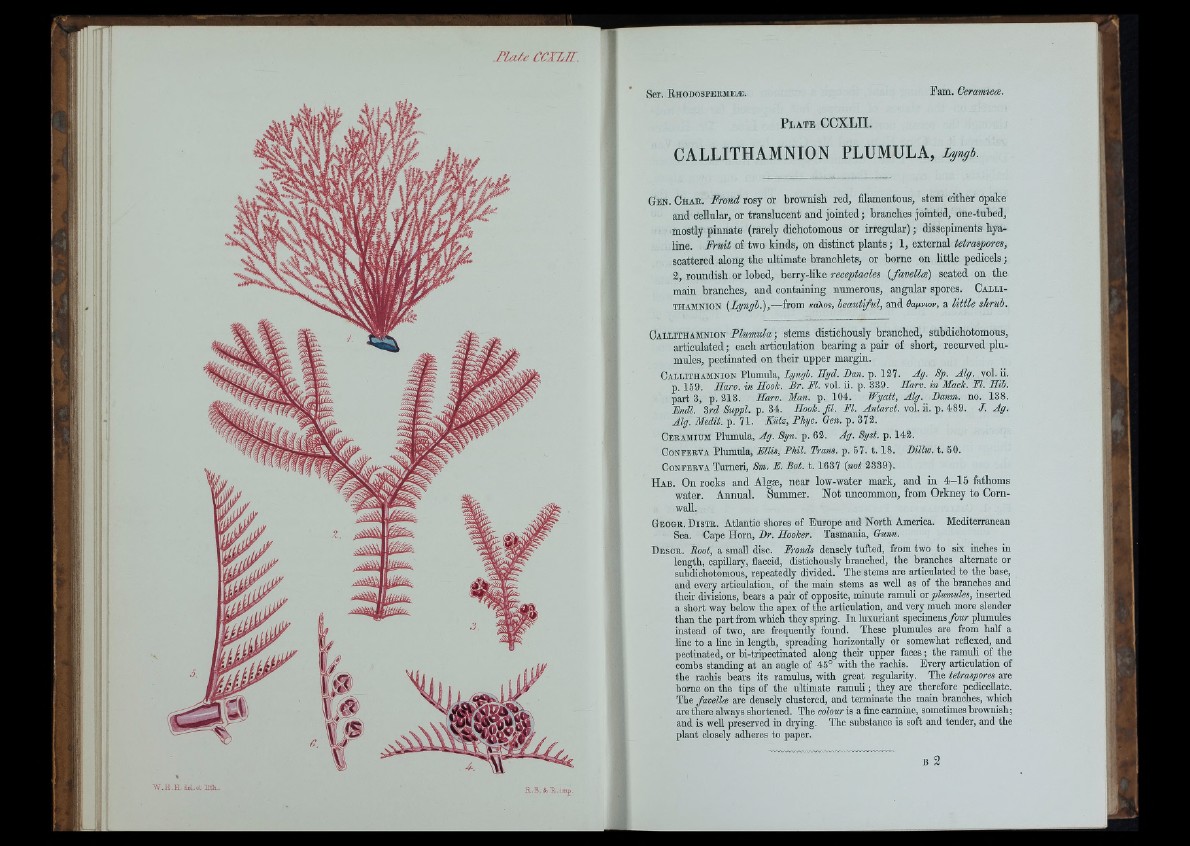
n a /: e CCTLJl .
P l a t e CCXLII.
CALLITHAMNION PLUMULA, L y n g b .
G e n . C h a e . Frond rosy o r b row n ish red , filamentous, stem e ith e r opake
an d c ellular, o r tr a n s lu c e n t a n d jo in te d ; b ra n c h es jo in te d , on e -tu b ed ,
mostly p in n a te (rarely dichotomous o r irreg u la r) ; dissepiments hya lin
e . F rm t of tw o k in d s , o n d is tin c t p la n ts ; 1, e x te rn a l tetraspores,
s c a tte re d a lo n g th e rd tim a te b ra n ch le ts, or b o rn e o n little pedicels ;
2, ro u n d ish or lobed, b e rry -lik e receptacles {favellæ) sea ted on th e
m a in b ra n ch e s , a n d c o n ta in in g n um e ro u s , a n g u la r spores. C a l l i -
THAMNION {Lyngh.),— from /oaXos, beautiful, an d Bagviov, a Utile . ’ ’
Oallithamnion Plumula ; stems distichously branched, subdichotomous,
articulated; each articulation bearing a pair of short, recurved plumules,
pectinated on their upper margin.
C A L L ITH AM N IO N Plumula, ifyîiyà. 71«. p. 127. Ag. Sp. Alg. vol. ii.
p. 1B9. S a n . in Hook. Br. M. vol. ii. p. 339. H a n . in Mack. M. Hib.
part 3, p. 213. Harv. Man. p. 104. Wyatt, Alg. Banm. no. 138.
Endl. Zrd Suppl. p. 34. Hook. fil. El. vol. ii. p. 489. J. Ag.
Alg. Medit. p. 71. Kiitz, Bhyo. Oen. p. 372.
Cebamium Plumula, Ag. Syn. p. 62. Ag. Syst. p. 142.
Conferva Plumtda, Ellis, Phil. Trans, p. 57. t. 18. BilVw. t. 50.
Conferva Turner!, Sm. E. Bot. 1 .1637 {not 2339).
H ab. On rooks and Algæ, near low-water mark, and in 4 -1 5 fathoms
water. Annual. Summer. Not uncommon, from Orkney to Cornwall.
Gbogr. D is t b . Atlantic shores of Europe and North America. Mediterranean
Sea. Cape Horn, Br. Hooker. Tasmania, Gunn.
Descb. Boot, a small disc. Eronds densely tufted, from two to six inches in
length, capillai-y, flaccid, distichously branched, the branches alternate or
subdichotomous, repeatedly divided. The stems are articulated to the base,
and every articulation, of the main stems as weU as of the branches and
their divisions, bears a pair of opposite, minute ramuli or plumules, inserted
a short way below the apex of the articulation, and very much more slender
than the part from which they spring. In luxuriant specimens four plumules
instead of two, are frequently found. These plumules are from half a
line to a line in length, spreading horizontally or somewhat reflexed, and
pectinated, or bi-tripeotinated along their upper faces ; the ramuli of the
combs standing at an angle of 45° with the rachis. Every articulation of
the rachis bears its ramulus, with great regularity. The tetraspores are
borne on the tips of the ultimate ramuli ; they are therefore pedicellate.
The favellæ are densely clustered, and terminate the main branches, which
are there always shortened. The colour is a fine carmine, sometimes brownish;
and is well preserved in diying. The substance is soft and tender, and the
plant closely adheres to paper.
- ^ ^
. im£.